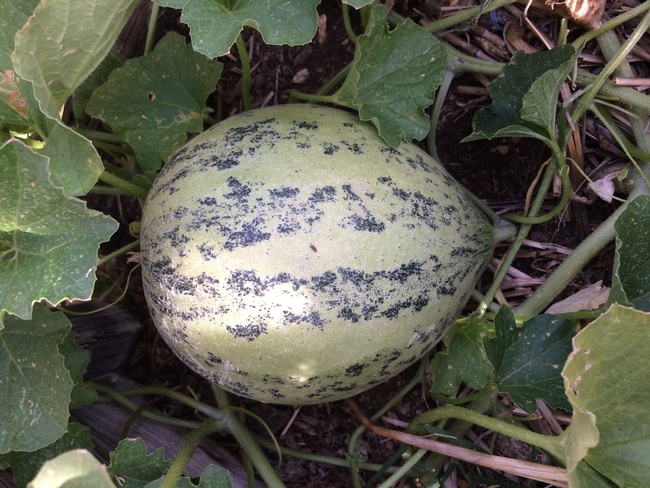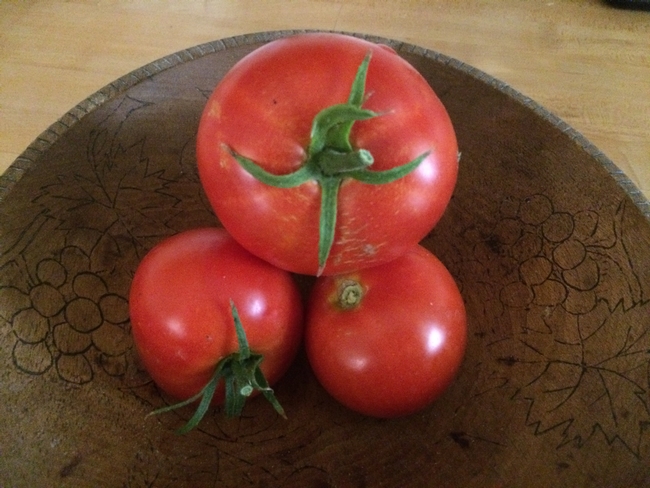It is definitely harvest time in my garden - I guess it has been for awhile. Like all good gardeners, I browsed the seed catalogs and found two new varieties to try out this season: Burbank Red Slicing Tomato and Crane Melon. My choices were inspired by a trip to Santa Rosa and the Luther Burbank Garden. What a treat to walk in the garden of a man that left such a horticultural legacy. Read on to find out more about these two winners. Both are listed by the The Slow Foods Ark of Taste, a catalog of distinctive foods deemed threatened by industrial standardization. They are definitely two to try!
Crane Melon
In Sonoma County, the last name of Crane is pretty much synonymous with the word melon. The Crane family has been farming melons there for more than a century.
It all started when Richard Crane was enticed to set down roots in the area because of the Gold Rush. But it was his son, Oliver Crane, who succeeded in breeding a golden melon that grew incredibly well in the unique clay soil and climate of Sonoma County, and without much irrigation. Named the Crane melon, it is a cross between several heirloom varieties: a Japanese melon, an ambrosia melon, a white melon and a Persian melon.
Beginning in the 1920s, Oliver sold his melons out of the farmstead's barn in Santa Rosa. Today, six-generations later, it has become an iconic landmark known affectionately as the “Melon Barn” where the family continues to farm and sell these melons. The Crane Melon is not found at grocery stores as it is vine ripened, and does not have the shelf life to be shipped. The Crane family claims that, “The Crane melon's flavor is due to its terroir. The melon was developed to be grown...in a particular soil, within a specific climate zone, farmed in a certain style.”
The Crane Melon has appeared in magazines, newspapers and TV shows. A Los Angeles Times article recognized it as a true heirloom. A striking melon it is slightly pear shaped with a gently tapering end and averages 4 to 7 pounds. Its exterior is a pale dusty green color with dark green blotches that become a rusty orange when fully ripe. The inner orange flesh is firm and succulent This melon is described as highly aromatic and exceptionally sweet and juicy with notes of honey, rose and orange blossom.
Over the past month, I have eaten several of these delectable melons from my own generous vine. They are quite big and make a lovely dessert. I am not sure that the soil here has the same terroir, but I can truly say they are the best melons I have ever tasted.
Burbank Red Slicing Tomato
Developed around 1914 by plant wizard Luther Burbank, this tomato was reportedly the only variety that Mr. Burbank raised for canning. It is a semi-determinate that grows on stocky bushes 18 - 36" tall and produces beautiful 6 - 8 oz fruits perfect for slicing and canning. Quite productive and a fairly early tomato, it has no problem with cool nights and even seems to tolerate drier climates. The fruit is a deep red color with a satisfying bold tomato flavor.
In his own words, Burbank described this tomato as, ”The earliest, smoothest, largest and most productive of all early tomatoes. It is of a bright red, the flesh being firm and of superior quality. The plants resist disease in an unusual manner, and unlike most early tomatoes, it produces heavily all summer. A fine home or market tomato, as it is a fine keeper and shipper."
The 1923 Burbank Seed Catalog reads, ”Fruit, bright crimson; thick, solid, heavy, smooth, medium to large in size, superior quality, unusually heavy and continuous bearer throughout the season. Good keeper and fare shipper. The Burbank has one other unique and most remarkable quality which will be appreciated by those who like fresh sliced tomatoes for the table. Unlike other tomatoes, the skin peels freely from the rich, firm flesh. “
All summer, I have been enjoying these fine tomatoes in sandwiches and salads, as well as cooking them down to paste for winter use.

